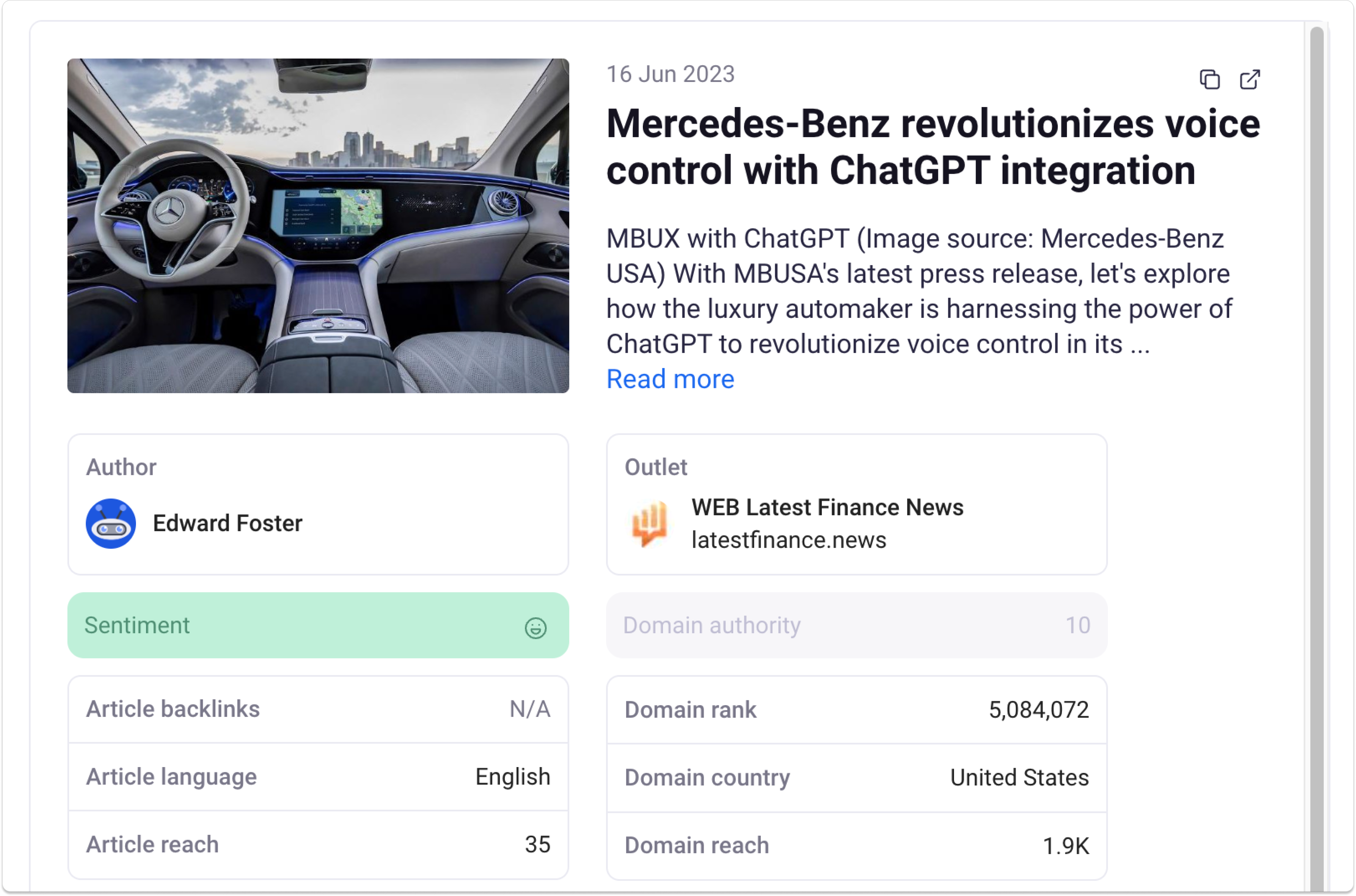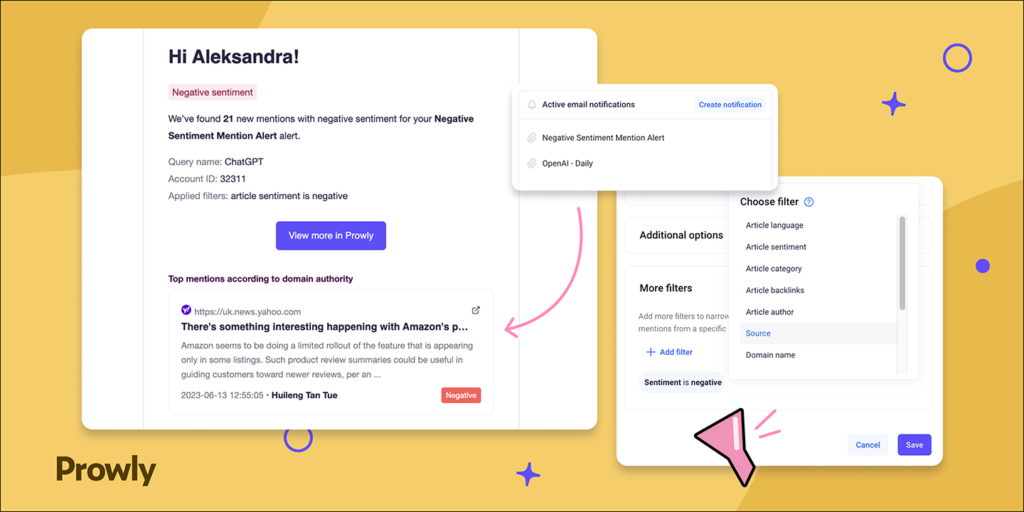How can you develop an effective PR strategy to conquer your industry without knowing who is talking about you and what are they saying? The answer is quite simple - you can’t.
Whether you work at a PR or marketing agency, run your own business or are a public figure, media monitoring can give you an edge over your competitors and allow you to be one step ahead of everyone else. The key is knowing how to do media monitoring effectively to get the most precise results and information you need.
It’s time to analyze all the business opportunities, past, current, and future trends, as well as emerging crises to take charge of your media presence and reputation. Let’s take a look at how to productively maneuver through media monitoring.
- What media should I monitor?
- What information should I monitor?
- Media monitoring - tips & best practices
Want to start monitoring the media 24/7? Try Prowly for free.
What media should I monitor?
Daily media monitoring is without a doubt considered a tedious practice. In the past, PR professionals had to manually find and collect clippings for hours on end and structure them in a specific format to present them to others later, as well as keep themselves organized.
Nowadays, media monitoring tools save us literally hundreds of hours. While it seems easy to simply enter a keyword and let technology do its job, there are several useful practices on how to do media monitoring to maximize your searches.
Are you curious about how media mentions can boost your brand's visibility? Read our guide about media mentions and learn how to track them effectively.
Let’s start off with a brief overview of what media you should monitor:
Media outlets
The cornerstone of all media monitoring practices is to monitor media content shared by outlets from all over the world. Who knows, maybe you have lots of strong, positive opinions about your product or brand in a region you did not assume you’d want to target?
With examples like these, you can monitor outlets and find opportunities for more business and more media coverage. Daily brand monitoring also allows you to filter the most relevant publications you care about and see who is saying what and where.
Social media
Monitoring social media platforms is surely one of the most important business analytics processes. To stay informed about your audience and listen in to what they have to say about you, it’s crucial to monitor channels such as Twitter, Facebook, Instagram, YouTube, and others.
An effective media monitoring tool will help you filter information in the posts, replies, and even comments from other users. Once you get that information, you can then gather insights from the reactions and sentiments your audience has about you, a brand, or a campaign.
Online forums & communities
Social platforms aren’t the only place people express their opinions. Depending on the industry and field of expertise you’re in, there are several online communities to monitor. These include Reddit, Quora, Stack Overflow, Steam, and many more.
Finding online forums and communities may not be the easiest thing to do if you have a niche business, but that’s why tools like daily media monitoring are priceless. Not only will you know what they are saying about you, you will also be able to locate your target audience and which online networks they frequent the most.
Although most newspapers, magazines, and publications are readily available online, it is still worth monitoring who is saying what about you offline.
Collecting clippings manually is a daunting task, especially since most print media come out every single day. That’s when a media monitoring solution takes all that work off your hands.
Here's the Practical Guide to PR Clippings for your PR agency if you'd like to delve a bit deeper into the topic.
Broadcast
We live in a digital age, but most people still get their latest news by watching television. If your business or brand depends on TV or radio, those are the channels you should be monitoring as well.
Once you have gathered all the data from media monitoring, what's next? If you're looking for the best way to present the data, you need to create a media report.
What information should I monitor?
Now that you know where to look, it’s time to evaluate what information you should be monitoring exactly. Having all the data is the first step, but knowing what to do with it is an art in itself.
There are tons of different ways on how to do media monitoring. Most of the time, these depend on what you are trying to accomplish and your respective end goal.
Are you monitoring the newest campaign and watching reactions and the sentiment your audience has towards it? Are you trying to gain more in-depth knowledge about the competitors you have in a particular niche industry? Or maybe you simply want to measure the strength of your current strategies against previous approaches?
To use media monitoring effectively, you should ask yourself what are your goals and do they align with your KPIs or other relevant objectives.
A media monitoring software can help you better understand your target audience, evaluate your strategies, analyze your brand perception and reputation, identify potential influencers and journalists you’d wish to contact, and much more.
Brand mentions
By looking at who is mentioning your brand and where, you can control brand awareness and adjust your PR & marketing strategy. Knowing where your brand is mentioned can help you evaluate who your target audience is, what people are saying about your brand, and even prevent an upcoming crisis.
This method is also relevant for keeping tabs on your own name, company, or even a particular campaign. Not all media monitoring tools are created equal, so make sure to pick one that also shows historical data to examine previous brand mentions as well.

Competitors
Monitoring your own performance and brand is important, but knowing what your competitors are up to is more than just an essential practice you should be implementing in your strategy if you haven’t already.
Taking a closer look at their successes and failures can help you anticipate their next move, adjust your own strategy and gather valuable insights on your own performance against others in your respective industry.
If you know how to do media monitoring well, you can take advantage of their shortcomings and be one step ahead. These are just a few media monitoring tips you can use for competitor analysis:
- Keep an eye on the social platforms they use
- Track their backlinks to create a potential outreach list for yourself
- Find influencers they’re working with
- Set up alerts for their new mentions
- Analyze sentiment in comments and reviews
Suppliers and vendors
Does your or your client’s business depend on external providers? Monitoring the market is important and will help you determine whether suppliers and vendors’ services will be restricted by ongoing restrictions, delivery accidents, or even politics.
It doesn’t really matter if your products are physical or digital. The latter can also be affected by, for example, viruses or bugs. Monitor relevant keywords to know how these sudden changes may impact you or your client and subsequently draft an impromptu response strategy.
Important keywords
Depending on your industry and marketing targets, the bottom line is to keep an eye on everything that might directly or indirectly affect your brand or company. Aside from monitoring the name of your own brand, tracking social media and your competition, there are other powerful ways on how to do media monitoring and get the most out of the tool.
Here are a few examples when playing around with different keywords that might be useful:
1. You’re in the real estate business
Look up keywords such as “apartments New York”, “rent laws 2023”, “luxury real estate Los Angeles”, “worst neighborhoods Connecticut”. These might help you take your business to the next level and spot potential opportunities for earned media coverage.
2. You run a non-profit
Although the keywords you choose have to be related to your specific organization, some of the words and phrases you may be interested in are “tech volunteer”, “healthcare donations”, “goodwill ambassadors” or even the names of major donors and popular journalists that often cover charity and non-profit stories.
3. You do PR for food industries
Depending on the exact branch, you might want to check out keywords such as “food trends 2023”, “food inflation”, “sugar free beverages” and many others.
You get the idea.
Backlinks
I’m sure you’ve heard about the importance of digital PR and how it’s shaping today’s PR industry. Having high-quality, relevant backlinks can boost your online visibility and reputation.
Measuring the number and quality of backlinks can help you acquire new customers and more business. If you have valuable backlinks, these can help skyrocket your position in Google’s results. More importantly, you can always track your competitors’ backlinks as well and see where to find backlink opportunities.
Media monitoring - tips & best practices
Knowing how to do media monitoring effectively is the most important aspect of using the tool itself. Here are a few tips you should implement in your strategy:
Narrow down your search
You will save hours on top of hours by getting the most relevant information you need.
For example, if you run an e-commerce business that specializes in shoes, don’t waste time on all mentions that have the “shoes” keyword.
This tip may be a no-brainer for many PR professionals, but it’s crucial not to get sidetracked by all the possibilities media monitoring has to offer. To get the most precise results, use as many filters as you can.
Watch out for spelling and context
This is perhaps one of the simplest media monitoring tips but happens so often it’s definitely worth highlighting. There are tons of posts on social media that might be talking about you or your brand, but what if they are misspelled? You have no way of finding them.
For example, if your name is “Ana”, try to search for “Anna”, “Anne” or “Ann” as well.
Additionally, check the context of the keyword you’re looking for. While “Apple” is a brand, it’s also a fruit or a name. To get the most optimal results, don’t forget to pick a specific keyword type to match what you’re looking for.
Use alerts to avoid missing opportunities
Whether you’re interested in how well your new campaign or product is performing, it’s smart to stay up to date on any new mentions. A quality media monitoring service should be able to alert you right in your mailbox when something interesting happens.
Setting up alerts is crucial to monitor abnormal activity on any keywords, brands, or competitors you want to track. It’s also useful in preventing an upcoming media crisis by receiving updates on a surge in bad sentiment alerts.

Take advantage of sentiment analysis
With a stellar media monitoring tool, you should be able to monitor the sentiment of any keywords and backlinks you’re after. Positive and negative sentiment can help you determine which one of your strategies works well and which developments you should act on immediately or readjust in the future.
Receiving lots of bad sentiment is a sight no PR professional wants to see, but there are ways you can use it in practice other than preventing a media crisis.
For each bad sentiment you found, you can implement a risk management practice and respond to all comments and negative reviews you received.
Organize your mentions
This is a crucial step that will save you a lot of time in the long run. While everyone has their own preference when it comes to organizing their work, there are many features a good media monitoring tool should offer to help you out.
Take your time to file all of your mentions and put them into separate projects. You should also be able to add mentions to clippings, tiers or sort them out by sentiment, country etc. It’s better to do it in the beginning and set yourself up for the future, rather than spend days on organizing mentions down the line.
Psst! Here's a list of the best social listening tools available on the market.
You can also learn all about using social monitoring for PR from The Complete Social Media Listening Guide for Public Relations.
Conclusion
If you want to monitor media content the right way, it’s important to know how to do media monitoring well. The sooner you start monitoring yourself, your brand, or your competitors, the sooner you will be able to gather all insights and use them for your PR and marketing campaigns, new business opportunities, risk management, and much more.
Once you're at it, you might want to check what Prowly has to offer. It's an all-in-one workflow automation solution for PR professionals that supports users in media monitoring, finding the right media contacts, and managing email pitches, just to name a few.
Cover photo by Markus Winkler

